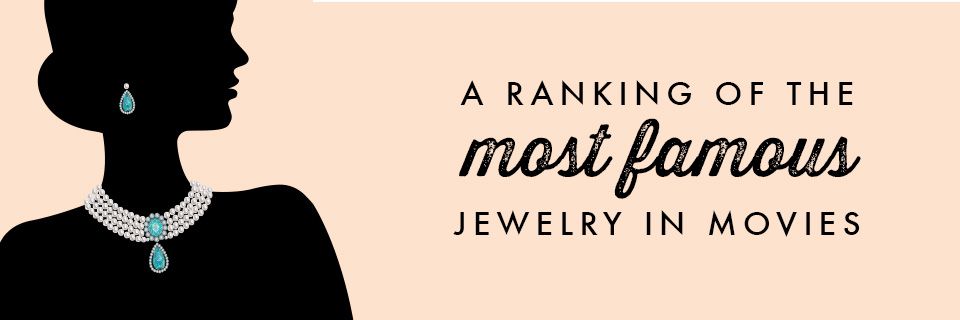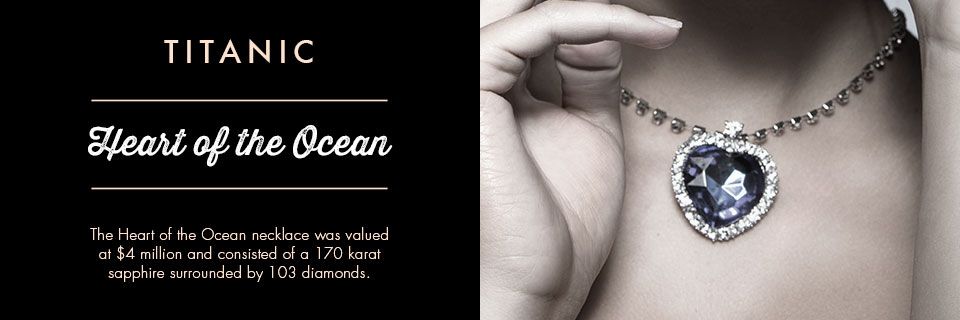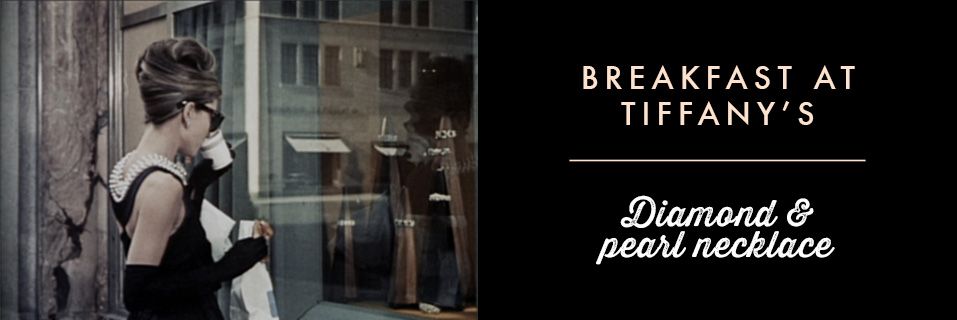A RANKING OF THE MOST FAMOUS JEWELRY IN MOVIES

Movies are usually remembered for their characters, their plot or their timeless storylines. But what viewers often don’t consider is the incredible amount of time that’s spent selecting the wardrobe, location and additional accessories and backdrops. All of these additions to a movie are what create the complete package, making a so-so movie into a memorable one. Even the most talented actors can’t carry a movie where all of the seemingly minor details have not been given primary consideration.
When considering famous movie jewelry, there are many fine pieces that come to mind, but there’s also one fine piece that truly stands out above the others — especially since a major focus of that particular movie concerned that piece of jewelry and what has happened to it over the years.
“ Titanic”

The Heart of the Ocean sapphire featured in “Titanic” was a beautiful pendant that, in the movie, was said to have once belonged to Louis XVI and made into a heart shape following the French Revolution. While the fictitious Heart of the Sea was actually based upon the Hope Diamond, the prop in the movie was not really a blue diamond. The prop of La Coeur de la Mer was actually a blue cubic zirconium with a white gold setting, and was created by Asprey & Garrad, who are London jewelers.
Famed jewelry designer Harry Winston designed a real pendant, which was worn by actress Gloria Stuart to the 1997 Academy Awards. Stuart played the older Rose in the movie, and wore one of the most expensive pieces of jewelry ever worn to an Academy Awards ceremony. The piece designed by Winston was valued at $4 million and consisted of a 170 karat sapphire surrounded by 103 diamonds.
What many don’t realize is that there is some truth to the story of the Heart of the Ocean. Passenger Kate Florence Phillips was only twenty-years-old when she was given a sapphire and diamond necklace by Henry Samuel Morley, a forty-year-old married man who traveled with Kate in second class.
Kate had been an assistant at one of Morley’s candy shops in London. Before sailing on the Titanic, Morley gave his wife and twelve-year-old daughter the proceeds he received from the sale of two of his shops. He and Kate decided that they were going to America, where they would be married under the names of Mr. and Mrs. Marshall. Kate survived the sinking of the Titanic, but, unfortunately, Henry did not.
Kate lived in New York for a few months with a couple who had agreed to let her live with them. After learning that she was pregnant, Kate moved back to England and lived with her grandparents, who raised her daughter, after she was born almost exactly nine months after the Titanic’s fateful voyage. Kate wasn’t content to be raising her young daughter, Ellen, and didn’t treat her very well. She eventually remarried.
Ellen tried continually to get Henry Morley’s name added to her birth certificate, but was not successful. Because of financial reasons, Ellen was forced to sell the necklace to a woman in Florida. Ellen died in 2005 in Worcester, England when she was 92. She had always wished that she could have proved that Henry Morley was her father.
“Breakfast at Tiffany’s”

The diamond and pearl necklace worn by Audrey Hepburn in the movie “ Breakfast at Tiffany’s” was a truly iconic piece of jewelry worn in movies, and has been copied many times throughout the years. Paired with Hepburn’s Givenchy simple black dress and white gloves, the Tiffany pearl and diamond stranded necklace was the perfect accessory for Hepburn’s character of Holly Golightly.
“Gentlemen Prefer Blondes”
1953’s “ Gentlemen Prefer Blondes” is possibly one of the most well-known movies starring the actress Marilyn Monroe. In addition, the pendant worn by Monroe in this movie may have been one of the oldest pieces of jewelry used in movies, as it was over 500 years old at the time.
Originally owned by the Maharajah of Baroda, India, it was later worn by Empress Maria Theresa of Austria and, at one time, was worn by Marie Antoinette. In fact, Nadir Shah stole the diamond from the Maharajah in 1739, and it was later returned it to the Maharajah 200 years later. In 1943, it was bought by Meyer Rosenbaum of Detroit, and he let Monroe borrow it for the movie. The diamond was auctioned by Christie’s in 1991.
The popularity of diamonds increased greatly following this movie. In fact, the popularity of diamonds increased so much that, by the end of the 1950s, a diamond engagement ring was considered to be a vital part of getting engaged. This was partially due to the creation of the slogan “ a diamond is forever,” which was coined by an advertising agency for a company called De Beers.
“Pretty Woman”
“ Pretty Woman” is a movie that seems to have everything a girl could want: Romance, comedy and a hunky hero. Julia Roberts’ memorable laugh originated from a scene that had been part of a prank orchestrated by co-star Richard Gere and the crew. Gere snapped the jewelry box closed at the same time Roberts was reaching for the diamond and ruby necklace, but the prank was so good that the director decided to keep it in the movie.
This piece of movie prop jewelry was valued at $1.35 million and had 23 rubies cut into the shape of pears, which resided in the middle of diamond hearts.
“How to Lose a Guy in Ten Days”
“ How to Lose a Guy in Ten Days” starred Kate Hudson in the 2003 comedy that featured one of the most expensive pieces of jewelry from movies. The Harry Winston-designed pendant was an 84-karat Isadora necklace.
This $5 million piece of jewelry was so unusual that the designers needed to create a dress to match the necklace.
“Sex and the City 2”
“ Sex and the City 2” is a memorable movie series — maybe not so much for the content but more for the way it inspired fashion. That’s why the engagement ring that Mr. Big gave to Carrie Bradshaw is considered to be one of the most famous movie rings.
This particular ring was a black diamond ring, which was five carats set in 18-karate gold and surrounded by 80 transparent pave diamonds. Actress Sarah Jessica Parker — Carrie — actually helped the designer, Itay Malkin, put the finishing touches on the ring.
“The Lord of the Rings” and “The Hobbit”
The “Lord of the Rings” trilogy and “The Hobbit,” by J.R.R. Tolkien, are novels in which the One Ring is an evil symbol of greed that was created in Mount Doom. The only way this ring can be destroyed is if it’s thrown into the volcano in which it was created. While there were about fifteen replicas made of the true artifact, the ring itself for the movies was 18-karat gold and was crafted in New Zealand by Jens Hansen Gold & Silversmith.
A lesser-known piece of jewelry in this movie was a necklace owned by Arwen Undomeil, a character played by actress Liv Tyler. She gave this necklace to her paramour, Aragon, played by Viggo Mortensen. This reminder of their love also represented the immortality of Arwen, and was called the EvenStar pendant. The pendant was designed by costumer designer Ngila Dickinson.
“Moulin Rouge”
The beautiful diamond necklace which adorned the neck of courtesan Satine in the movie “ Moulin Rouge” was given to her by the Duke of Monroth, had an estimated value of $1 million and was complete with 134 karats with over 1,000 diamonds. The garland design featured in this necklace was very popular in late Victorian times.
“Gone With the Wind”
“Gone with the Wind” is not a movie that usually comes to mind when one is thinking of iconic jewelry. Nevertheless, the cameo broach which Vivian Leigh wore on her mourning gown really stood out — to the point where it became an instant classic.
The cameo broach was set in gold, and borrowed from the mother of the costume designer to use specifically in the movie.
“The Other Boleyn Girl”
The necklace worn by Natalie Portman in “ The Other Boleyn Girl” is significant because it resembled the actual necklace that adorned Ann Boleyn’s neck, as depicted in her portraits. This particular necklace had a string of pearls with a gold initial “B” and three teardrop-shaped pears hanging below.
Viewers of the movie could see the necklace on Portman’s neck when Ann Boleyn returned to France after failing to keep the attention of King Henry VIII.
Other Movies Well-Known for Their Jewelry
James Bond established early on in his career as a spy that, as a superior secret agent, he went first-class all the way. His wristwear epitomized that image, and he wore a Rolex Submariner watch exclusively when the first “Bond” movie premiered in 1962. Years later, Bond started wearing an Omega Seamaster, which, like its predecessor, was outfitted with a variety of super spy tools that were designed to assist 007 in getting out of the most dire situations.
Next up: An important-but-tiny jewel the size of a marble was found in the movie “Men in Black,” and was actually a small galaxy which hung from a cat’s collar. The titular Men in Black were tasked with protecting this galaxy as part of the theme of the movie.
Diamonds play a lesser role in director Quentin Tarantino’s “Reservoir Dogs.” The thieves’ efforts to divide the diamonds among themselves became contentious and result in much violence, though the viewers never actually get to see the diamonds in question.
Gold-plated and made primarily from bronze, the pirate medallion from “The Pirates of the Caribbean: The Curse of the Black Pearl” was based upon real Aztec coins, and is complete with a skull in the center. The legend behind the coin states that the people who removed the coins from the chest were cursed and became members of the living dead. The only way they could be returned to the land of the living would be to return the coins to the chest and make a blood sacrifice.
Cartier designed the six-karat pink diamond rink featured in the movie “Lust, Caution.” A halo setting was used to create the illusion of a bigger diamond. The ring was a significant prop in the movie, as the character who received the ring was a seductress intent on seducing the man who gave it to her. Yet, the seduction would likely result in his death. After receiving the ring, the seductress couldn’t bring herself to complete her mission.
A very important image from “The Hunger Games” was the image of the Mockingjay pin. This symbolized not only the district where heroine Katniss Everdeen lived, but also represented her quest to rebel. The pin showed a mockingjay bird holding an arrow, and was cast in sterling silver with a 22-karat gold plating.
Finally, “The NeverEnding Story” featured a symbol called the Auryn, which, when worn, gave the wearer the power to grant any of their wishes. It symbolized infinity and consisted of an entwined silver and gold snake.
Hidden Movie Jewelry
There has been much jewelry used in movies over the years — so much that a number of pieces were actually rediscovered a few years ago in a warehouse in Burbank. The warehouse had served as a studio for Joseff of Hollywood, who was a jewelry maker for some of the most famous movie stars.
As these pieces were movie props, they’re “merely” costume jewelry — but have nevertheless begun to be considered valuable in recent years. Joseff kept the pieces instead of letting the movie studios keep them, and actually made money renting them out over the years.
Eugene Joseff’s daughter-in-law, Tina, is one of the proprietresses of the warehouse, and showcases the most famous pieces of jewelry in a circular glass display case in a corner of the small studio inside the warehouse. Pieces inside the case include Marilyn Monroe’s earrings from “Gentleman Prefer Blondes,” Elizabeth Taylor’s belt from “Cleopatra,” the necklace worn by Scarlett O’Hara in “Gone With the Wind,” a brooch worn by Jean Harlow in “Libeled Lady,” a cigar case used by Clark Gable in “Gone With the Wind,” and a necklace worn by Judy Garland in “Ziegfeld Follies.” There are many other pieces that are stored in drawers and trays along the walls.
Eugene’s wife, Joan, worked with him in the business. In an anecdotal tale about Elizabeth Taylor, Tina tells how Joan had measured Taylor for the snake belt that Taylor wore in Cleopatra. While Joan was certain that she measured correctly, Taylor insisted she didn’t. The consummate professional, Joan knew she would not argue with Taylor, but merely added length to the belt despite the fact that she was sure she had measured correctly. While it was a known fact that Taylor’s weight fluctuated during that period of time, it was something that those working with her didn’t comment upon.
Joseff also created a beautiful necklace worn by Bette Davis in “The Private Lives of Elizabeth and Essex.” The nine strands of fake pearls are connected by crystals in a gold plating.
Greta Garbo refused to wear a faux diamond and emerald necklace for the movie “Camille” in 1936. The very tight choker had pointed silver leaves that actually cut into her neck. She had to wear a cape over it.
In Errol Flynn’s “The Adventures of Don Juan,” he wore a single pearl earring. The Joseffs made him 22 of the earrings, as he kept losing them through his misadventures with women between takes, despite the rumors that he was gay.
The movie “The Jungle Book” required many thousands of jewelry pieces, including breastplates, belts and cuffs. Sometimes, Joseff would need to replace the rhinestones that had come off the armor during the day, due to the exertions of filming.
Eugene Joseff moved to Hollywood in 1928 after working in advertising in Chicago. After learning how to work in art foundry, he was able to make a variety of items out of bronze, including statues. While Joseff was very creative, he also realized his limitations. He studied art at museums and reviewed historical publications. Joseff and his brother, Jimmy Glaser, started the Sunset Jewelry Manufacturing company, experimenting with making costume jewelry in his garage. Though Jimmy left the company, he continued to work by himself.
He was aggressive enough that he could find out what movies were in production and would call the studios to tell them that he believed he could provide the jewelry for the film. His work was the first of its kind. Prior to his designing specific jewelry for film, there really wasn’t much jewelry used in film, or the stars supplied and accessorized themselves.
But Joseff was working on a limited budget and worked to ensure his continued success. In order to do that, he decided to make the pieces as they were ordered. In order to ensure future profits, he decided to add to his collection and rent the pieces to various studios in order to continue building his portfolio.
The plating method that was Joseff’s signature technique gave his pieces a Renaissance look that other companies have tried to duplicate with little success. Actresses in the 1930s and 1940s started asking Joseff to make them copies of pieces that they wore in their films. Joseff even started selling his pieces in the retail market at stores such as Neiman Marcus, Macy’s and Saks Fifth Avenue.
Joseff’s workshop is still behind the studio where employee Lucy Koch continues to put pieces together by hand after working there for half a century.
Shortly before the United States entered World War II in 1941, Joseff started Precision Investment Castings, a jet parts company still in existence today.
In the late 1930s, Joseff hired a secretary to help him with the business. He hired Joan Castle, and gradually the two fell in love. The pair married in 1942 and had son Jeff in 1947. The business continued to boom into the late 1940s until tragedy struck. Joseff was flying his own plane when a piloting error caused the plane to crash, killing everyone aboard. Joan took over the business after his death and continued to operate it until she died at the age of 97 in 2010.
During the 1950s, movie stars wanted to wear real jewelry, rather than costume jewelry — especially after Prince Rainier III gave his bride, Grace Kelly, Cartier jewels. Studios then started to develop their own stores of jewelry to use in movies.
Joseff was able to continue with a few niches, including providing jewelry to television shows such as “I Love Lucy” and, later, “Dynasty and Dallas.” Fortunately for the Joseff family, the Precision Investment Castings business continued to do well — especially with the evolution of NASA.
Joseff of Hollywood jewelry is still sold at specialty stores for the price tag of between $100 and $2,000, and may occasionally appear in some television shows or movies. They still rent some of their pieces, but they have refused to rent some of the more iconic pieces, such as the cigar case used by Clark Gable in “Gone With the Wind.” The iconic pieces are true film treasures and have appeared at museum shows across the world.
If you’re seeking your own special, one-of-a-kind piece of jewelry, browse the fine jewelry available at Thom Duma Fine Jewelers. Who knows? Maybe you’ll find a Heart of the Ocean of your very own!

